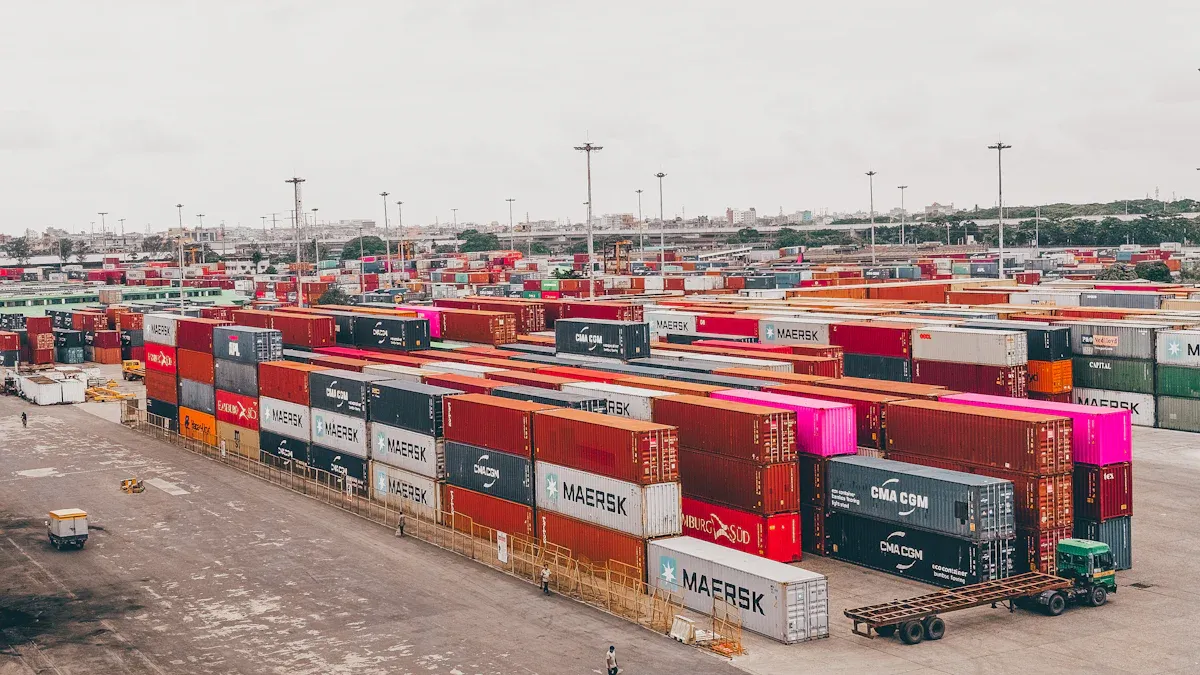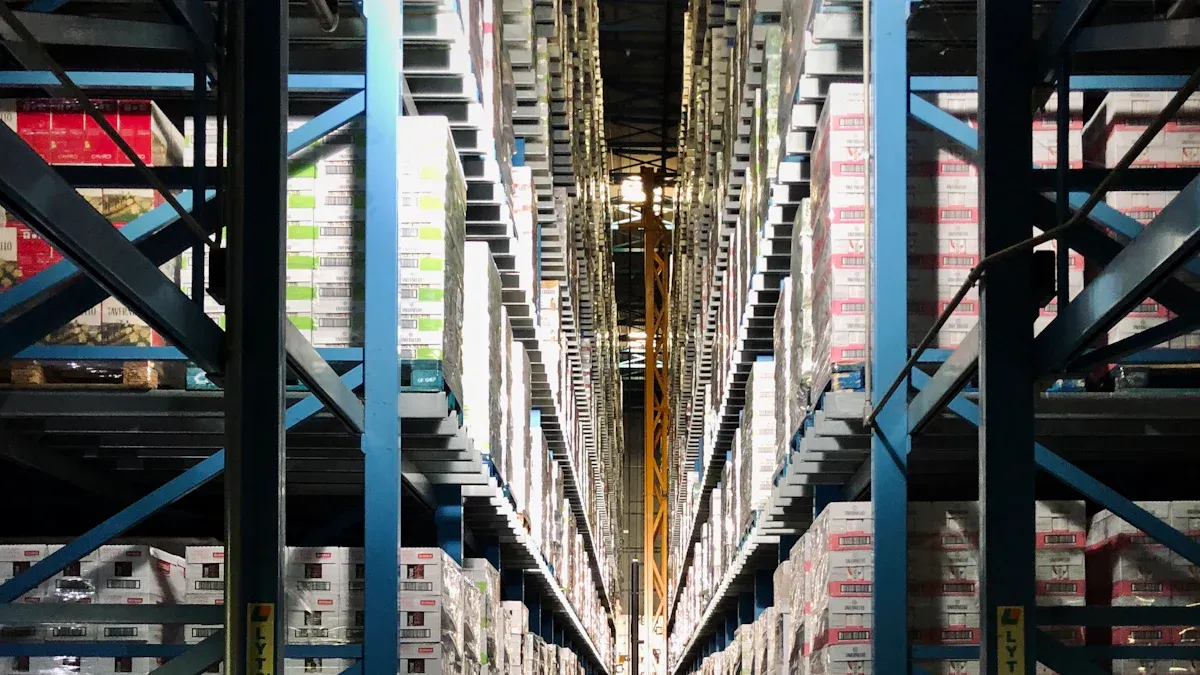Behind the Surge in Demand for Overseas Warehouses: Driving Factors and Opportunities

Global logistics is undergoing a massive transformation. Businesses are racing to meet the growing expectations of today’s shoppers who want their orders faster than ever. This has fueled a surge in demand for overseas warehouses, reshaping how goods move across borders.
The global on-demand warehousing market is expected to skyrocket from USD 108 billion in 2023 to USD 360.2 billion by 2033, with a CAGR of 12.8%.
In 2023, over 41% of this market was dominated by the Asia-Pacific region, generating USD 44.28 billion.
Around 60% of companies are now exploring on-demand warehousing to streamline operations.
These numbers reveal how businesses are adapting to shifting trade dynamics and consumer preferences, making overseas warehouses a critical element of modern supply chains.
Key Takeaways
The need for warehouses in other countries is growing fast. It may rise from $108 billion in 2023 to $360.2 billion by 2033.
Online shopping is growing, so faster deliveries are needed. Warehouses in other countries help businesses keep customers happy.
Storing goods closer to buyers saves time and money. It also helps companies be quicker and kinder to the environment.
Using robots and smart tools in warehouses makes work faster. It also reduces mistakes and helps businesses do better.
Working with local companies improves delivery plans. It also follows rules and makes customers happier.
Driving Factors Behind the Surge in Demand

E-Commerce Growth and Cross-Border Trade Expansion
The rapid growth of e-commerce has revolutionized global trade. Consumers now have access to international marketplaces at their fingertips, thanks to smartphones and widespread internet connectivity. This accessibility has fueled a growing demand for unique and cost-effective products from around the world. As a result, businesses are expanding their cross-border operations to meet these demands.
E-commerce platforms make it easier for consumers to purchase products from different countries, offering them a wider range of choices.
Logistics providers have simplified international trade by partnering with shipping services that specialize in cross-border deliveries.
Improved payment gateways and global shipping options have further encouraged international purchases, driving the need for efficient logistics networks.
The surge in demand for overseas warehouses is closely tied to this e-commerce boom. These facilities enable businesses to store products closer to their customers, reducing delivery times and enhancing the overall shopping experience. As cross-border trade continues to grow, the role of overseas warehouses becomes even more critical in meeting consumer expectations.
Impact of Trade Policies and Tariff Adjustments
Trade policies and tariff changes have significantly influenced the logistics landscape. For instance, the imposition of additional tariffs on Chinese goods has prompted many businesses to rethink their supply chain strategies. To avoid high tariffs, companies are pre-stocking goods in overseas warehouses located in key markets like the United States.
Evidence Type | Description |
|---|---|
Warehousing Utilization | The Logistics Managers’ Index (LMI) shows a significant rise in warehousing utilization relative to capacity since August, indicating increased demand for storage due to tariff concerns. |
Freight Pull Forward | Shippers are preemptively storing freight in warehouses due to fears of tariff increases, leading to higher utilization rates. |
Reshoring Impact | Anticipated tariffs may accelerate the reshoring of manufacturing, influencing demand for domestic warehousing solutions. |
Additionally, the "China + 1" strategy has gained traction. This approach involves diversifying supply chains by retaining China’s manufacturing capabilities while shifting some operations to nearby countries like Mexico. Such strategies not only mitigate risks but also take advantage of tariff benefits under agreements like the USMCA. As a result, the demand for overseas warehouses in regions like North America has surged, further solidifying their importance in global trade.
Supply Chain Localization and Near-Shoring Trends
The global supply chain is evolving rapidly. Businesses are shifting their focus from distant offshoring to localized and nearshore operations. This trend is reshaping logistics strategies and driving the demand for overseas warehouses. Companies are no longer relying solely on far-flung manufacturing hubs. Instead, they are moving production and storage closer to their key markets. Why? To reduce costs, improve efficiency, and respond faster to customer needs.
Near-shoring offers several advantages. For starters, it slashes transportation costs significantly. According to Deloitte, businesses can save between 20-40% on transportation expenses by nearshoring compared to traditional offshoring. Shorter distances also mean faster delivery times. Shipping goods from Asia to the U.S. takes an average of 59 days. In contrast, nearshoring to Mexico cuts that time down to just 22 days. This speed is a game-changer for companies aiming to meet the growing consumer demand for quick and reliable deliveries.
Benefit | Insight |
|---|---|
Transportation Cost Savings | Nearshoring reduces transportation costs by 20-40% (Deloitte, 2022). |
Faster Lead Times | Shipping from Mexico takes 22 days compared to 59 days from Asia. |
Inventory Optimization | Companies report 25-35% reductions in inventory due to better demand visibility (Gartner, 2023). |
Lower Carbon Emissions | Nearshoring cuts transportation-related emissions by 30-60% (MIT, 2022). |
Improved Responsiveness | Perfect order fulfillment rates improve by 40-65% with nearshoring (APICS, 2023). |
Total Cost Advantages | Nearshoring offers overall cost improvements of 5-15% (Accenture, 2022). |
Localization and near-shoring also enhance supply chain resilience. By diversifying operations across multiple regions, businesses can mitigate risks associated with disruptions in a single location. For example, the "China + 1" strategy allows companies to retain China's manufacturing strengths while shifting some operations to nearby countries like Mexico. This approach ensures continuity even during geopolitical or economic uncertainties.
Opportunities Created by the Surge in Demand

Automation and Smart Warehousing Solutions
The rise in demand for overseas warehouses has sparked a wave of innovation in logistics. Companies are turning to automation and smart warehousing solutions to keep up with the fast-paced global market. These technologies are transforming how warehouses operate, making them faster, smarter, and more efficient.
Automation tools like Autonomous Mobile Robots (AMRs) and robotic arms are becoming common in warehouses. They help businesses reduce errors and speed up operations. For example, Amazon introduced Proteus, a fully autonomous warehouse robot, to streamline its processes. This shift toward automation isn’t just about speed—it’s also about accuracy. By integrating AI and machine learning, warehouses can predict demand more effectively and optimize inventory levels. This means fewer stockouts and better decision-making.
The numbers back this up. In 2022, the transportation and logistics sector accounted for nearly 20% of the smart warehousing market. Retail and e-commerce businesses are also jumping on board, with a growth rate of 15.4% in automated supply chain solutions. These advancements show how automation is reshaping the logistics landscape, creating opportunities for businesses to thrive in a competitive market.
Expansion into Emerging Markets
Emerging markets are becoming a hotbed of opportunity for overseas warehouses. Regions like Latin America, Asia, and the Middle East are experiencing rapid growth in e-commerce, creating a strong demand for efficient logistics solutions. Businesses that expand into these markets can tap into a growing consumer base and drive significant revenue growth.
Take Latin America, for example. E-commerce in the region is expected to grow by 20% annually, with the number of online shoppers projected to reach 419 million in the next four years. Similarly, U.S. exports to the UAE exceeded $24.8 billion in 2023, marking a 19% increase from the previous year. These numbers highlight the immense potential of emerging markets.
However, entering these markets isn’t without challenges. Retailers must navigate local regulations, such as Mexico’s new tariff rules and LATAM’s consumer tax ID requirements. Adapting to these changes is crucial for success. By investing in overseas warehouses and building strong local partnerships, businesses can overcome these hurdles and establish a foothold in these high-growth regions.
The expansion into emerging markets represents a golden opportunity for businesses to grow and diversify. With the right strategies, companies can unlock the full potential of these regions and stay ahead in the global logistics race.
Strategic Partnerships with Local Providers
Building strategic partnerships with local providers has become a cornerstone for businesses leveraging overseas warehouses. These collaborations help companies navigate the complexities of foreign markets while ensuring smooth operations. By working with local experts, businesses can unlock a range of benefits that enhance their logistics strategies and customer satisfaction.
Challenges in the Overseas Warehouse Industry
Workforce Shortages and Skill Development
The overseas warehouse industry faces a growing challenge: finding skilled workers to meet operational demands. As online shopping continues to expand, the need for warehousing and storage services has skyrocketed. However, automation in warehouses has reduced the demand for manual labor, creating a shift toward roles requiring technical expertise.
The rise of data centers and advanced logistics systems has increased the demand for skilled professionals who can manage data storage and processing.
Companies are investing in education and training programs to address talent shortages and improve operational efficiency.
Without skilled workers, inefficiencies and even security risks can disrupt warehouse operations.
Despite automation reducing some labor needs, the overall demand for warehousing services remains strong. Businesses must balance technology adoption with workforce development to ensure smooth operations.
Rising Operational Costs and Real Estate Prices
Operational costs and real estate prices are two of the biggest hurdles for overseas warehouses. Choosing the right location is a balancing act. Companies must weigh real estate expenses against transportation costs to optimize logistics and prioritize delivery speed.
Warehouses near suppliers and customers reduce fuel costs and delivery times, but these areas often come with higher property prices.
Densely populated regions with a large talent pool tend to have elevated real estate costs, but the benefits of faster delivery often justify the expense.
Investing in high-cost areas can enhance customer satisfaction by improving delivery speeds.
Real estate costs are a critical factor in warehouse location decisions. Businesses must evaluate operational efficiency, logistics, and local labor markets alongside property expenses to maximize profitability.
Regulatory Compliance and Trade Restrictions
Navigating regulatory compliance and trade restrictions is another significant challenge. International rules and interconnected supply chains make compliance management increasingly complex. Businesses must stay ahead of evolving regulations to avoid costly disruptions.
Data engineering and network mapping technologies help companies monitor compliance with customs regulations and tariffs.
Predictive analytics identify potential compliance risks early, saving time and resources.
Visual insights from network mapping allow businesses to track supply chain dynamics and ensure adherence to industry standards.
By leveraging advanced technologies, companies can streamline compliance processes and minimize errors. Staying proactive in regulatory management is essential for maintaining smooth global operations.
Sustainability and Environmental Concerns
Sustainability has become a major focus for businesses operating overseas warehouses. Companies are under pressure to reduce their environmental impact while maintaining efficiency. This shift isn’t just about meeting regulations—it’s about responding to consumer demand for greener practices.
Sustainability isn’t just good for the planet—it’s good for business. Companies that prioritize eco-friendly practices often see improved brand loyalty and reduced costs. For example, cutting emissions can lower fuel expenses, while recycling programs reduce waste disposal fees.
Consumers are also driving this change. Many shoppers prefer brands that align with their values, including environmental responsibility. By adopting sustainable practices, businesses can attract eco-conscious customers and gain a competitive edge.
Adapting to Rapid Technological Changes
Technology is reshaping the overseas warehouse industry. Businesses are embracing innovations to improve efficiency, accuracy, and customer satisfaction. These changes aren’t optional—they’re essential for staying competitive in a fast-moving market.
Warehouses are integrating advanced tools to streamline operations:
Barcode scanners connected to Warehouse Management Systems (WMS) speed up processing times. This integration reduces delays and ensures products move quickly through the supply chain.
Automation and real-time tracking enhance inventory accuracy. These technologies help businesses avoid stockouts and overstocking, saving money and improving customer experience.
Cloud computing and SaaS platforms enable live inventory tracking. These systems integrate seamlessly with e-commerce platforms, allowing businesses to respond to demand in real time.
The impact of these technologies is clear. A study found that RF handheld devices and Vehicle Mounted Units (VMU) improved warehouse activities by 65%. Error rates dropped from 12% to 3%, while automation increased the volume of processed packages by 48%.
Adapting to technological changes isn’t just about efficiency—it’s about survival. Companies that fail to innovate risk falling behind competitors who leverage these tools. By investing in technology, businesses can reduce costs, improve accuracy, and deliver faster service.
The future of overseas warehouses lies in innovation. As technology continues to evolve, businesses must stay agile and embrace new solutions to thrive in the global logistics landscape.
The surge in demand for overseas warehouses marks a turning point in global logistics. Businesses are rethinking their strategies to adapt to this evolving landscape. While challenges like workforce shortages and sustainability concerns remain, the opportunities for growth and innovation are immense. Companies that invest in technology, prioritize eco-friendly practices, and build strong partnerships will lead the way. This shift isn’t just about logistics—it’s about creating a smarter, more resilient supply chain for the future.
FAQ
How do overseas warehouses benefit small businesses?
Small businesses can use overseas warehouses to compete globally. These facilities allow them to offer faster shipping, reduce logistics costs, and handle returns more efficiently. It’s a game-changer for reaching international customers. 🚀
Are overseas warehouses eco-friendly?
Yes, they can be! By storing goods closer to customers, overseas warehouses cut down on long-distance shipping, reducing carbon emissions. Many warehouses also adopt sustainable practices like recycling and energy-efficient operations. 🌱♻️
What challenges do businesses face with overseas warehouses?
Businesses often face challenges like high real estate costs, regulatory compliance, and workforce shortages. Adapting to local markets and managing operational expenses can also be tricky. However, strategic planning and partnerships can help overcome these hurdles.
See Also
Discovering Enhanced Efficiency With JUSDA's Latest Warehousing Solutions
Understanding Current Trends in Logistics Risk Management
Addressing Global Supply Chain Growth Challenges Effectively
Harnessing Robotics Technology to Boost Warehouse Efficiency
Transforming Future Logistics Through AI-Driven Supply Chains
